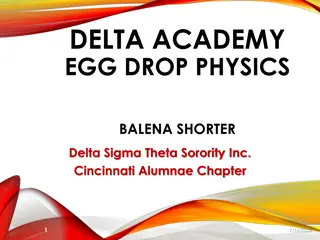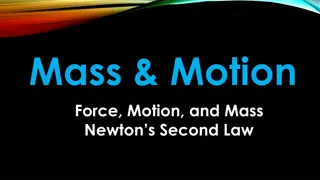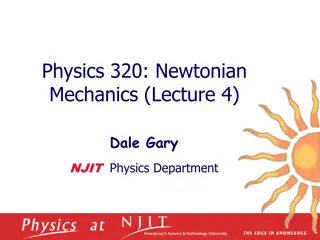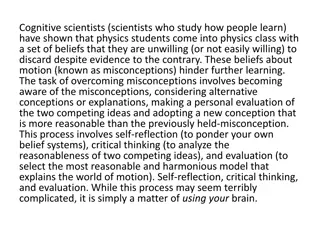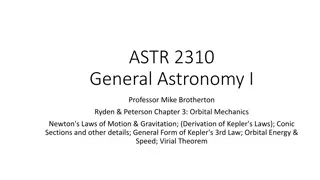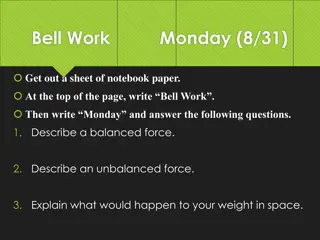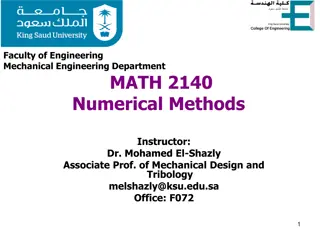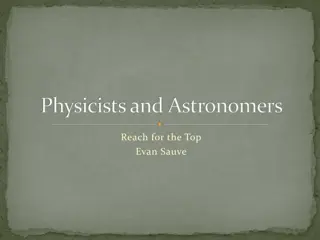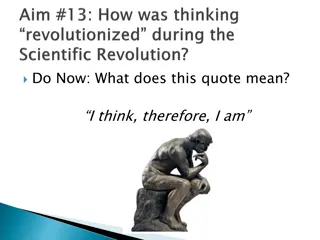Understanding Newton's Laws of Motion: A Comprehensive Overview
Explore a detailed examination of Newton's Laws of Motion, delving into what Newton truly said about each law and comparing it to modern textbook definitions. Discover the essence of the First, Second, and Third Laws with insightful commentary and accompanying visuals illustrating key concepts. Engage with the fundamental principles governing motion and forces in this enriching exploration of classical physics.
Download Presentation

Please find below an Image/Link to download the presentation.
The content on the website is provided AS IS for your information and personal use only. It may not be sold, licensed, or shared on other websites without obtaining consent from the author. Download presentation by click this link. If you encounter any issues during the download, it is possible that the publisher has removed the file from their server.
E N D
Presentation Transcript
PHYS 160-3H2 0830-0920 Thursdays Planetary Hall Room 220 Week 4 with Dr. Harold A. Geller Office: Planetary Hall Room 233
First, Some Comments on First, Some Comments on What Newton Really Said What Newton Really Said
The First Law of Motion According to Your Textbook An object acted on by no net external force has a constant velocity (which may be zero) and zero acceleration.
What Newton Really Said about Law I Every body perseveres in its state of rest, or of uniform motion in a right line, unless it is compelled to change that state by forces impressed thereon.
The Second Law of Motion According to Your Textbook If a net external force acts on an object, the object accelerates. The direction of acceleration is the same as the direction of the net external force. The mass of the object times the acceleration vector of the object equals the net external force vector.
What Newton Really Said about Law II The alteration of motion is ever proportional to the motive force impressed; and is made in the direction of the right line in which that force is impressed.
The Third Law of Motion According to Your Textbook If object A exerts a force on object B (an action ), then object B exerts a force on object A (a reaction ). These two forces have the same magnitude but are opposite in direction. These two forces act on different objects.
What Newton Really Said about Law III To every action there is always opposed an equal reaction; or the mutual actions of two bodies upon each other are always equal, and directed to contrary parts.
Physics Homework Problem Presentation
iClicker Question Compared to the inertia of a 1 kg mass, the inertia of a 4 kg mass is A one-fourth as great B one-sixteenth as great C 16 times as great D 4 times as great
iClicker Question Compared to the inertia of a 1 kg mass, the inertia of a 4 kg mass is A one-fourth as great B one-sixteenth as great C 16 times as great D 4 times as great
iClicker Question If the mass of a moving object could be doubled, the inertia of the object would be A halved B doubled C unchanged D quadrupled
iClicker Question If the mass of a moving object could be doubled, the inertia of the object would be A halved B doubled C unchanged D quadrupled
iClicker Question The fundamental units for a force of 1 newton are A meters per second2 B kilograms C meters per second2per kilogram D kilogram * meters per second2
iClicker Question The fundamental units for a force of 1 newton are A meters per second2 B kilograms C meters per second2per kilogram D kilogram * meters per second2
iClicker Question An object with a mass of 2 kilograms is accelerated at 5 meters per second2. The net force acting on the mass is A 5 N B 2 N C 10 N D 20 N
iClicker Question An object with a mass of 2 kilograms is accelerated at 5 meters per second2. The net force acting on the mass is A 5 N B 2 N C 10 N D 20 N
iClicker Question A cart is uniformly accelerating from rest. The net force acting on the cart is A decreasing B zero C constant D increasing
iClicker Question A cart is uniformly accelerating from rest. The net force acting on the cart is A decreasing B zero C constant D increasing
iClicker Question A carpenter hits a nail with a hammer. Compared to the magnitude of the force the hammer exerts on the nail, the magnitude of the force the nail exerts on the hammer during contact is A less B greater C the same
iClicker Question A carpenter hits a nail with a hammer. Compared to the magnitude of the force the hammer exerts on the nail, the magnitude of the force the nail exerts on the hammer during contact is A less B greater C the same
iClicker Question A cart is uniformly accelerating from rest. The net force acting on the cart is A decreasing B zero C constant D increasing
iClicker Question A cart is uniformly accelerating from rest. The net force acting on the cart is A decreasing B zero C constant D increasing
iClicker Question If the mass of an object were doubled, its acceleration due to gravity would be A halved B doubled C unchanged D quadrupled
iClicker Question If the mass of an object were doubled, its acceleration due to gravity would be A halved B doubled C unchanged D quadrupled
iClicker Question What is the weight of a 5.0 kilogram object at the surface of the Earth? A 0.5 N B 5.0 N C 49 N D 490 N
iClicker Question What is the weight of a 5.0 kilogram object at the surface of the Earth? A 0.5 N B 5.0 N C 49 N D 490 N
iClicker Question For a freely falling object, the ratio of the force of gravity to its acceleration is A weight B momentum C kinetic energy D mass
iClicker Question For a freely falling object, the ratio of the force of gravity to its acceleration is A weight B momentum C kinetic energy D mass
iClicker Question The weight of a chicken egg is most nearly equal to A 10-3N B 10-2N C 100N D 102N
iClicker Question The weight of a chicken egg is most nearly equal to A 10-3N B 10-2N C 100N D 102N
Formulas Available for First Exam (expected)



